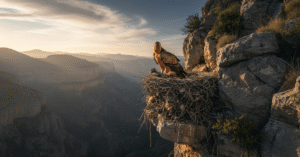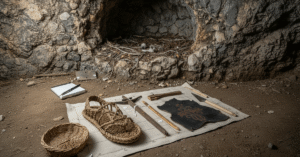As someone who loves digging into the dusty corners of history, I’ve learned that the most mind-blowing discoveries rarely happen in neat, well-organized museums. Instead, they’re often stumbled upon in the most unexpected places—a forgotten attic, an unmarked grave, or, in a truly bizarre twist, the abandoned nest of a huge bird. The tale of the 650-year-old shoe found in vulture nest Spain is one such discovery that genuinely makes you pause and marvel at the universe’s sense of humor. It proves that the most meticulous archaeologists in the world can sometimes be a species of magnificent, flying scavenger: the Bearded Vulture.
The Winged Archaeologists of Southern Spain

The fact that a piece of 14th-century footwear—a delicate sandal made of grass and sticks—was discovered high up in a large bird’s nest is a story that sounds like it was ripped straight from a fictional adventure novel. Yet, this is exactly what happened in the rugged, remote cliffs of southern Spain.
For centuries, Bearded Vultures (Gypaetus barbatus)—a powerful species of raptor often called the Lammergeier—built their massive nests in protected rock shelters. These birds are known for their territorial nature, reusing the same nest sites for decades, sometimes even centuries. And here is where the science gets fascinating: these nests, built in cool, dry cave environments, created a perfect ‘natural museum’ or ‘time capsule’ that preserved the materials within them with astonishing effectiveness.
You see, typical archaeological finds are buried under layers of earth, which usually causes organic materials like wood, leather, or grass to decompose. But high up in these nests, sheltered from rain and extreme heat, objects made of natural fibers were locked in time. The vultures, it turns out, weren’t just building homes; they were inadvertently collecting and preserving a history that humans had long forgotten.
More Than Just a Shoe: The Extraordinary Collection

This discovery wasn’t limited to a single shoe. The research team, after painstakingly excavating 12 abandoned nests layer by layer, uncovered an entire collection of artifacts that painted a detailed picture of medieval life. Imagine the scene: among eggshells, bones from animal prey, and natural nesting materials, archaeologists found a trove of human-made objects.
The most striking finds, alongside the 650-year-old shoe found in vulture nest Spain, included:
- Weapons: Fragments of a crossbow bolt and a piece of a wooden lance.
- Textiles: A decorated piece of sheep leather painted with ochre.
- Domestic Tools: Fragments of woven basketry and cordage.
This incredible haul gave researchers a tangible connection to the people who once lived in the area, showcasing what they wore, hunted, and crafted. It’s truly amazing to think that a Vulture, simply trying to reinforce its home, could have snatched a lost sandal or a broken slingshot from a field and then placed it carefully into a nest, thereby turning a common occurrence into an invaluable historical record.
Why This Fact is a Breakthrough for Archaeology
My experience tells me that breakthroughs like this are important not just for the objects themselves, but for what they teach us about methods. We usually look for ruins in the ground, but this shows that we should also be looking up!
The fact that the most valuable artifact, the 650-year-old shoe found in vulture nest Spain, survived intact is a massive gain for science. These items, dated accurately using Carbon-14 analysis, provide a precise timeline for human activity in the region during the 14th century, a period for which physical evidence of daily life is often scarce. It confirms that the Bearded Vultures acted as ‘accidental archaeologists’, collecting historical remnants over generations.
Furthermore, this discovery opens up a completely new avenue of research called Vulture-Mediated Archaeology. By studying other ancient bird nests in different regions, scientists now have a proven new method for finding well-preserved organic artifacts that traditional digging methods might miss.
This unique finding—all thanks to a massive bird that uses bones for decoration—is a powerful reminder that history is preserved in the most unpredictable and enchanting ways. The next time I think of an important historical site, I won’t just picture a dusty ruin; I’ll also be looking up at the high cliffs, wondering what other 650-year-old shoe found in vulture nest Spain might be waiting to tell its story. This tiny piece of footwear has truly given us a giant piece of the past.






